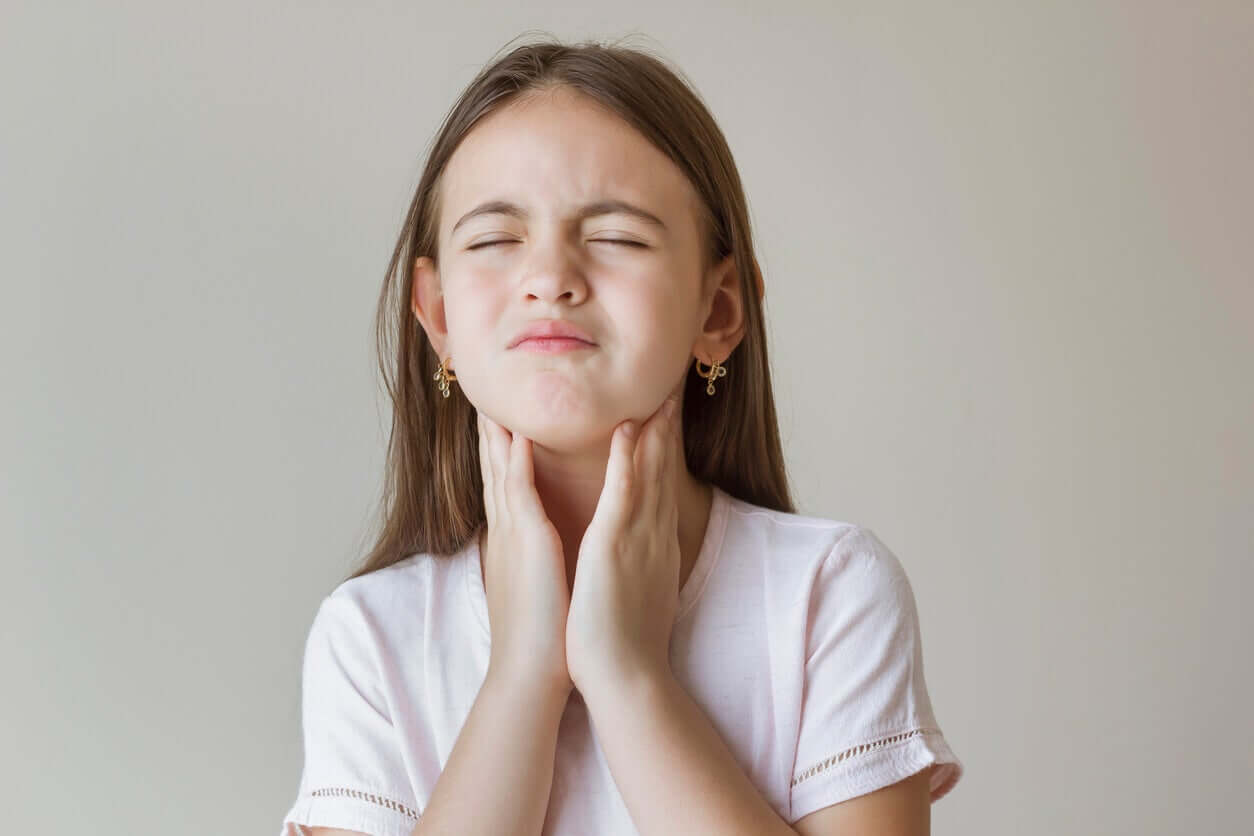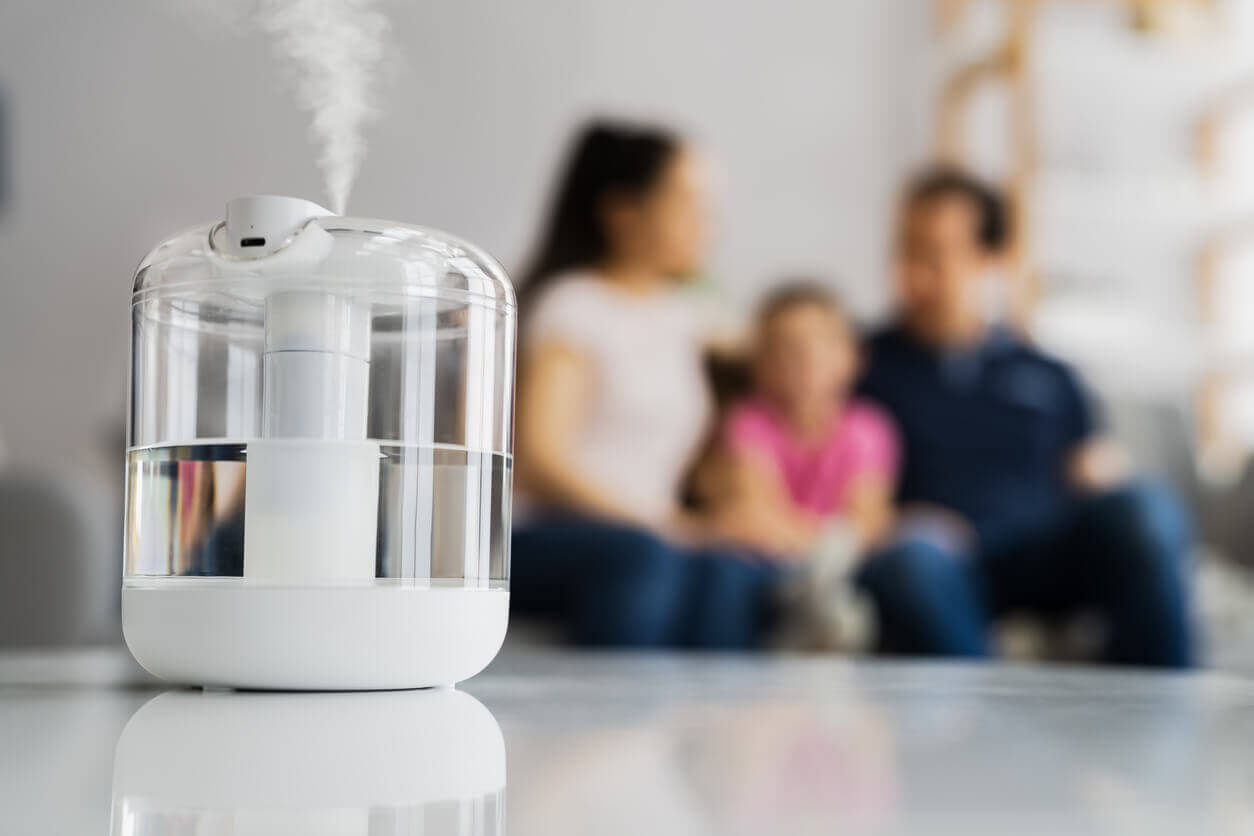Home Remedies for a Sore Throat in Children

An itching and burning sensation in the pharynx can make your little one feel very uncomfortable and upset. Fortunately, there are some effective home remedies to improve a sore throat in children.
Little ones can feel discomfort in the throat for various reasons: Viral or bacterial infections, allergies, colds, and even irritation caused by screaming too much.
Most of the time, a sore throat in children doesn’t require drug treatment and improves with certain natural strategies or with the passing of time. In general, after 4 or 5 days, the discomfort disappears. Either way, it’s important to be attentive and go to the pediatrician if new symptoms appear or the child’s condition worsens.
Next, we’ll share some recommendations to help your little one feel better.
A sore throat in children
As we mentioned, throat discomfort in children can be due to many causes. Changes in the weather, wearing wet clothes, and being exposed to air conditioning are the most frequent and typical causes of summer. But they can also be the consequence of viral and bacterial infections typical of the first colds.
In the event that the inflammation in the throat (pharyngitis) is of viral origin, spontaneous recovery usually takes about 5 to 7 days. On the contrary, infections of bacterial origin need to be treated with antibiotics. For this reason, it’s best to consult a pediatrician to define the origin of the problem and address it in the most appropriate way.

Home remedies for a sore throat in children
Traditional and home remedies can be very effective in relieving a sore throat in children. They’re not generally curative, but they’re especially useful for parents who want to avoid giving their children medication.
Either way, before giving any home remedy to a child, no matter how harmless it may seem, it’s best to consult with the pediatrician. In the same vein, it’s important to monitor the appearance of new symptoms, such as a high fever or signs of deterioration.
Next, we’ll share these 5 home remedies that you can use today to relieve a sore throat in children.
1. Good hydration
Proper hydration of the pharyngeal (throat) mucosa is essential in order to alleviate discomfort in this area. Dehydration reduces the production of saliva and mucus that lubricate this cavity and this increases its irritation.
As much as swallowing is uncomfortable, insist that the child drink plenty of fluids, such as water, teas, or warm (not hot) soups. If the baby is still breastfeeding, you should offer the breast frequently.
When offering food and drinks to the child, you need to be careful with their temperature. It’s best to warm the food and avoid extreme temperatures, as both can worsen the sensation of pain.
2. Gargle with saltwater
This home remedy is useful in children who already know how to spit and keep a liquid in the throat without swallowing it, which happens around the age of 6. It involves preparing a saline solution with 1 or 1/2 teaspoon of salt in 8 ounces of warm water and offering it to the little one to gargle with.
It’s important to motivate the child to carry out these rinses for a few seconds and repeat them 2 or 3 times a day. This is because the water hydrates the mucous membranes and the salt acts as a disinfectant and anti-inflammatory, which further alleviates irritation.
3. Tea with honey
A warm tea sweetened with honey may be one of the most popular home remedies for sore throats in children. The tea hydrates the mucous membranes and the honey, rich in vitamins and trace elements, acts as an anti-inflammatory and antimicrobial agent. In addition, it helps reduce the typical cough of colds.
The infusion can be prepared with black tea or green tea, which also act as an antibacterial and are a source of antioxidants. Once ready, two or three tablespoons of honey are added.
Ideally, this can be an enriched beverage with a few drops of lemon (source of vitamin C) or be infused with clean citric peel in order to exploit the antimicrobial and antiviral properties.
It’s very important to mention that honey can’t be used in infants under one year of age.
4. Light and easy to swallow food
Although it’s very important that children eat in the usual way, the act of eating itself can be uncomfortable and shouldn’t be forced. Ideally, you should offer them nutritious but light meals that are rich in carbohydrates and vitamins.
Chicken, meats, or vegetable broths are usually a healthy and easy-to-swallow option. In addition, the salt they contain acts as an anti-inflammatory.
Acidic foods, such as fruits and dairy, can increase discomfort and should be avoided.
5. Steam
Lubricated mucous membranes improve symptoms, so breathing humid air helps soothe a sore throat in children. Running a cool-mist humidifier in your room can go a long way.
In addition, you can take advantage of the mist that’s produced by a hot shower while the child is taking a bath.

What to avoid
There are some home remedies for a sore throat that may work well in adults, but should be avoided in children:
- Candies and pills with anesthetics: Most contain benzocaine, which can cause allergies and make it difficult for children to swallow.
- Over-the-counter pain relievers and anti-inflammatory drugs: While some of these products may be prescribed by a doctor, they shouldn’t be given to a child without a pediatrician’s prescription. Self-medication in children is very dangerous.
- Aspirin: Shouldn’t be given to children under 18 years of age due to the risk of Reyé syndrome, a rare but serious condition.
Consultation with the pediatrician never hurts
Natural remedies for sore throats in children are an adjunct to relieve symptoms, but not a curative treatment. For this reason, it’s advisable to take the child to the pediatrician to identify the origin of the problem and find the appropriate therapy.
Likewise, if you choose to relieve your little one with any of the home remedies that we share here, it’s best that you talk about it beforehand with a health professional.
Finally, if the sore throat increases or persists, is accompanied by fever, skin rashes, diarrhea, vomiting, or swollen lymph nodes, see your doctor immediately.
An itching and burning sensation in the pharynx can make your little one feel very uncomfortable and upset. Fortunately, there are some effective home remedies to improve a sore throat in children.
Little ones can feel discomfort in the throat for various reasons: Viral or bacterial infections, allergies, colds, and even irritation caused by screaming too much.
Most of the time, a sore throat in children doesn’t require drug treatment and improves with certain natural strategies or with the passing of time. In general, after 4 or 5 days, the discomfort disappears. Either way, it’s important to be attentive and go to the pediatrician if new symptoms appear or the child’s condition worsens.
Next, we’ll share some recommendations to help your little one feel better.
A sore throat in children
As we mentioned, throat discomfort in children can be due to many causes. Changes in the weather, wearing wet clothes, and being exposed to air conditioning are the most frequent and typical causes of summer. But they can also be the consequence of viral and bacterial infections typical of the first colds.
In the event that the inflammation in the throat (pharyngitis) is of viral origin, spontaneous recovery usually takes about 5 to 7 days. On the contrary, infections of bacterial origin need to be treated with antibiotics. For this reason, it’s best to consult a pediatrician to define the origin of the problem and address it in the most appropriate way.

Home remedies for a sore throat in children
Traditional and home remedies can be very effective in relieving a sore throat in children. They’re not generally curative, but they’re especially useful for parents who want to avoid giving their children medication.
Either way, before giving any home remedy to a child, no matter how harmless it may seem, it’s best to consult with the pediatrician. In the same vein, it’s important to monitor the appearance of new symptoms, such as a high fever or signs of deterioration.
Next, we’ll share these 5 home remedies that you can use today to relieve a sore throat in children.
1. Good hydration
Proper hydration of the pharyngeal (throat) mucosa is essential in order to alleviate discomfort in this area. Dehydration reduces the production of saliva and mucus that lubricate this cavity and this increases its irritation.
As much as swallowing is uncomfortable, insist that the child drink plenty of fluids, such as water, teas, or warm (not hot) soups. If the baby is still breastfeeding, you should offer the breast frequently.
When offering food and drinks to the child, you need to be careful with their temperature. It’s best to warm the food and avoid extreme temperatures, as both can worsen the sensation of pain.
2. Gargle with saltwater
This home remedy is useful in children who already know how to spit and keep a liquid in the throat without swallowing it, which happens around the age of 6. It involves preparing a saline solution with 1 or 1/2 teaspoon of salt in 8 ounces of warm water and offering it to the little one to gargle with.
It’s important to motivate the child to carry out these rinses for a few seconds and repeat them 2 or 3 times a day. This is because the water hydrates the mucous membranes and the salt acts as a disinfectant and anti-inflammatory, which further alleviates irritation.
3. Tea with honey
A warm tea sweetened with honey may be one of the most popular home remedies for sore throats in children. The tea hydrates the mucous membranes and the honey, rich in vitamins and trace elements, acts as an anti-inflammatory and antimicrobial agent. In addition, it helps reduce the typical cough of colds.
The infusion can be prepared with black tea or green tea, which also act as an antibacterial and are a source of antioxidants. Once ready, two or three tablespoons of honey are added.
Ideally, this can be an enriched beverage with a few drops of lemon (source of vitamin C) or be infused with clean citric peel in order to exploit the antimicrobial and antiviral properties.
It’s very important to mention that honey can’t be used in infants under one year of age.
4. Light and easy to swallow food
Although it’s very important that children eat in the usual way, the act of eating itself can be uncomfortable and shouldn’t be forced. Ideally, you should offer them nutritious but light meals that are rich in carbohydrates and vitamins.
Chicken, meats, or vegetable broths are usually a healthy and easy-to-swallow option. In addition, the salt they contain acts as an anti-inflammatory.
Acidic foods, such as fruits and dairy, can increase discomfort and should be avoided.
5. Steam
Lubricated mucous membranes improve symptoms, so breathing humid air helps soothe a sore throat in children. Running a cool-mist humidifier in your room can go a long way.
In addition, you can take advantage of the mist that’s produced by a hot shower while the child is taking a bath.

What to avoid
There are some home remedies for a sore throat that may work well in adults, but should be avoided in children:
- Candies and pills with anesthetics: Most contain benzocaine, which can cause allergies and make it difficult for children to swallow.
- Over-the-counter pain relievers and anti-inflammatory drugs: While some of these products may be prescribed by a doctor, they shouldn’t be given to a child without a pediatrician’s prescription. Self-medication in children is very dangerous.
- Aspirin: Shouldn’t be given to children under 18 years of age due to the risk of Reyé syndrome, a rare but serious condition.
Consultation with the pediatrician never hurts
Natural remedies for sore throats in children are an adjunct to relieve symptoms, but not a curative treatment. For this reason, it’s advisable to take the child to the pediatrician to identify the origin of the problem and find the appropriate therapy.
Likewise, if you choose to relieve your little one with any of the home remedies that we share here, it’s best that you talk about it beforehand with a health professional.
Finally, if the sore throat increases or persists, is accompanied by fever, skin rashes, diarrhea, vomiting, or swollen lymph nodes, see your doctor immediately.
All cited sources were thoroughly reviewed by our team to ensure their quality, reliability, currency, and validity. The bibliography of this article was considered reliable and of academic or scientific accuracy.
- Diomedi, A., Chacón, E., Delpiano, L., Hervé, B., Jemenao, M. I., Medel, M., … & Cifuentes, M. (2017). Antisépticos y desinfectantes: apuntando al uso racional. Recomendaciones del Comité Consultivo de Infecciones Asociadas a la Atención de Salud, Sociedad Chilena de Infectología. Revista chilena de infectología, 34(2), 156-174.
- Zavalu, V. M. C., Nazareno, C. V. A., Lopez, R. C. B., Cedeño, M. P. M., Villamar, J. D. C., & Loor, J. F. B. (2019). Principales manifestaciones causales de la presencia de rinofaringitis infantil. Polo del Conocimiento: Revista científico-profesional, 4(1), 133-159.
- Muñoz, C. M. M., Basurto, V. A. D., Anchundia, J. P. C., & Martinetti, G. G. H. (2021). Descripción y análisis de infecciones respiratorias agudas en niños menores de 5 años. Polo del Conocimiento, 6(9), 1108-1123.
- Freire Bedón, S. S. (2018). Cuidados empíricos en afecciones respiratorias en niños menores de 5 años en la comunidad de Illagua Chico (Bachelor’s thesis, Universidad Técnica de Ambato-Facultad de Ciencias de la Salud-Carrera de Enfermería).
- Bravo Bonoso, D. (2019). Afecciones Respiratorias Estacionalesen niños menores de 5añosdel Centro de Salud Rural Julcuy (Bachelor’s thesis, JIPIJAPA-UNESUM).
- Vera Rodriguez, T. E. (2021). Factores asociados a la Automedicación en la Faringoamigdalitis Agudas en niños y niñas menores de 6 años del Centro de Salud Chongon en el Periodo Enero-Diciembre del 2019 (Master’s thesis).
- Cano Varela, S. P., Cuevas Cárdenas, I. Y., & Oyóla Lamprea, A. X. Prácticas de cuidado en una comunidad de cuidadores de niños menores de cinco años con infección respiratoria aguda.
- de Bizkaia, F. D. C. (2019). de garganta.
- Lv, X., Zhao, S., Ning, Z., Zeng, H., Shu, Y., Tao, O., … & Liu, Y. (2015). Citrus fruits as a treasure trove of active natural metabolites that potentially provide benefits for human health. Chemistry Central Journal, 9(1), 1-14.
- Reygaert, W. C. (2014). The antimicrobial possibilities of green tea. Frontiers in microbiology, 5, 434.
- Peiró, P. S. (2019). Miel como medicina. Medicina naturista, 13(1), 34-37.
- HONEY, H. P. O. PROPIEDADES CURATIVAS DE LA MIEL: UN EDULCORANTE NATURAL PROVENIENTE DE LOS PRINCIPALES POLINIZADORES DE LAS PLANTAS.
- Dhanavade, M. J., Jalkute, C. B., Ghosh, J. S., & Sonawane, K. D. (2011). Study antimicrobial activity of lemon (Citrus lemon L.) peel extract. British Journal of pharmacology and Toxicology, 2(3), 119-122.
This text is provided for informational purposes only and does not replace consultation with a professional. If in doubt, consult your specialist.








